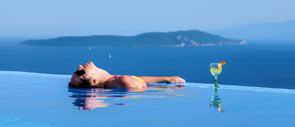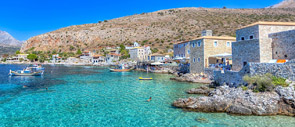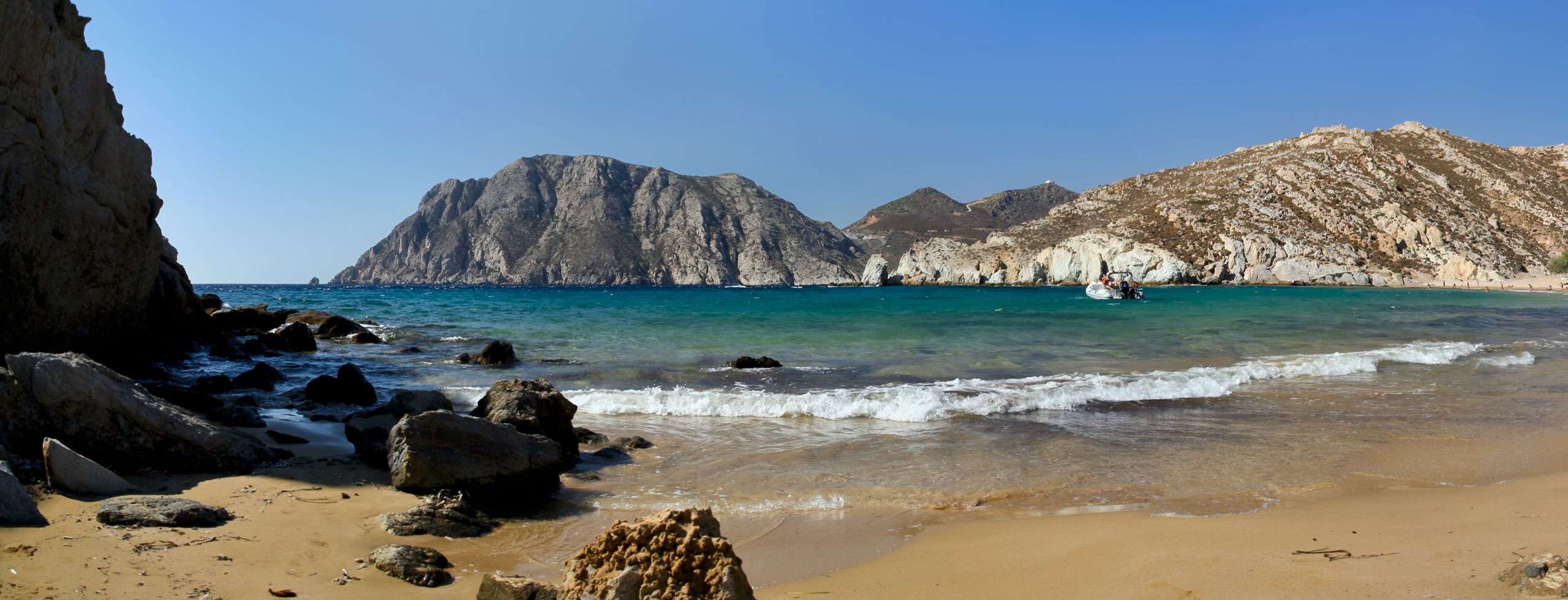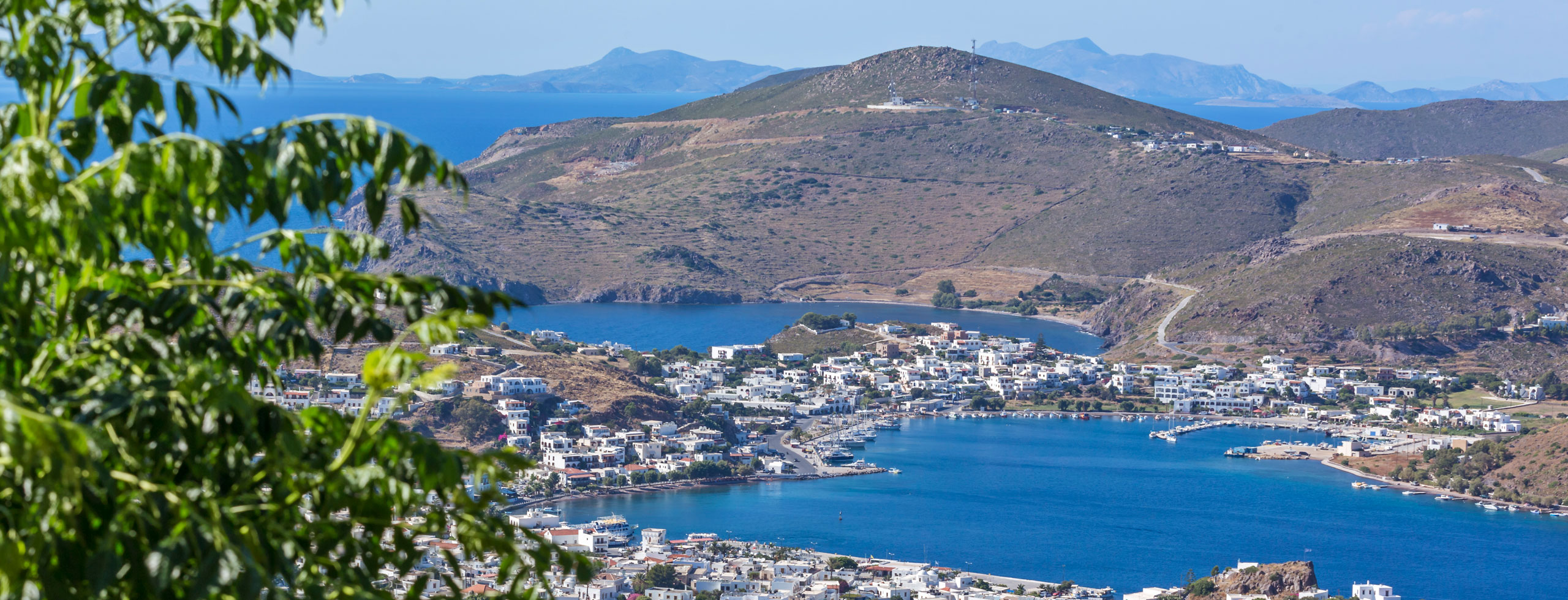Patmos Island Greece - Travel information, Patmos hotels, villas, tours, restaurants, beaches, archaeological sites, nightlife
For some years now, sophisticated travelers have been coming to Patmos to enjoy its fine hotels, restaurants, beaches, and quiet beauty. Its main village, Hora, is one of the most picturesque villages of the Aegean and a UNESCO World Heritage Site, while its neighboring tiny islands offer magical spots for a day cruise that will enchant even the most demanding visitor. The Monastery of St. John and the Cave of the Apocalypse are only part of the reason that the island is arguably one of the most spiritual locales in all of Greece. Whether because of its location off the main routes or its preservation of traditional ways of life, Patmos exudes a special serenity that will appeal to people no matter what their spiritual leanings.
Patmos: the Secret Gem of the Aegean
There may be more dramatic locales in the world, there may be more spectacular destinations around the globe, but few places on earth can match the extraordinary combination of features that draw people to the island of Patmos. Here on one relatively small plot of land–only some 16 square miles–is one of the most resonant sites of early Christianity, a site that has become a pilgrimage goal for both Orthodox Christians and Roman Catholics: the cave were St. John wrote the Book of Revelation. Here, too, is one of the best-kept secrets of international tourism: an island increasingly sought out by sophisticated travelers in search of a truly restful holiday. If there is a common theme to this island’s attractions it is that there is a sense of having arrived at a quiet space, respected by all who come ashore, whether they share the Christian faith or simply come to relax. Whatever it is, Patmos has this special aura.
Patmos Geographical Description
Patmos is not one of the Cycladic Islands but belongs to the group known as the Dodecanese–“The Twelve Islands”– whose capital is the city of Rhodes on the island of the same name. In fact, the group includes 14 major islands and over a hundred smaller islets. Patmos’s geographical profile itself is somewhat irregular–divided as it is into three sections joined by strips of land. Relatively hilly–its high point is some 890 feet–its volcanic soil and general aridity have always limited its agricultural product; instead, sponge-fishing long provided its main source of income.
The Cave of the Apocalypse and the Monastery of St. John
But clearly the prime attractions of Patmos are the sites associated with St. John: the Monastery is in Hora–literally, “the village”–that crowns the hill rising a bit south of Skala, and the Cave of the Apocalypse between Skala and Hora. It is in the cave that St. John is said to have dictated to his student, Prochoros, the book known as Revelation. Long ago converted into a chapel, the cave has various graffiti and wall paintings that have been added since the Middle Ages.
If the cave is the “ground zero” of apocalyptic Christianity, the Monastery of St. John the Theologian is the crown jewel of Patmos. It sits at the pinnacle of the village of Hora and entry (hours, dress code) is strictly controlled by the monks. The structures within–the monks’ living quarters, the refectory, the various sections of the church, and the Treasury–date from many centuries starting with the founding in the eleventh century. Visitors will find much to admire in the many architectural details, frescoes, and ikons. The library owns some of the rarest books and manuscripts of Christianity, including much of a 6th-century copy of the Gospel of St. Mark, while the Treasury’s holdings are regarded as the most important outside Mt. Athos (the great monastic community in northern Greece)–ikons, priests’ vestments, crosses, a chalice, and more. Perhaps it is something about ascending the hill up to the Monastery but people of any (or no) faith tend to count a visit to Hora – a truly astounding village - as both a necessary and rewarding part of a stay on Patmos.
Leisure on Patmos
Patmos lagged behind many of the Greek islands in gearing up for the international tourism that began to take hold in the 1960s, in part because its primary focus was on the spiritual nature of its past and sites. In the years since, tourist accommodations and amenities have emerged; but without claiming that Patmos is a religious retreat, a somewhat more subdued atmosphere pervaded the island. For some years now, sophisticated Greeks and Europeans have been coming to Patmos to enjoy its fine hotels, restaurants, beaches, and quiet beauty. Many of the hotels and restaurants are in or close to Skala but those seeking a bit of seclusion head for those in the northern or southern reaches (none of them, admittedly, very far from Skala, on an island only 8 miles long!). It is here, too, that the best beaches are found: to the north, this includes the bays of Agriolivado, Lambi, Vagia, Livadi Geranou, and Kampos; to the south, the bays of Grikou, Petra, and Psili Ammos. Even the nightlife on Patmos tends to be a bit more, shall we say, “civilized,” and if this is a characterization that appeals to you, then Patmos is for you.
Patmos Highlights:
- High Cultural Value and Spirituality
- Picturesque Scenery
- Extraordinarily Authentic & Intimate
Patmos History
Patmos boasts one of the most resonant histories of all the Greek islands. Under the Romans, it was a place to exile troublesome individuals, and among these was the Apostle John, also known as John the Divine. It was in a cave here, as tradition states, that John dictated his Book of Revelation, and because of this unique Biblical association, a great Monastery was built on the island in 1088 AD, revered and protected across the centuries by Roman Catholics as well as by Orthodox Christians. The Monastery's library and treasury are among the most important in the Christian world, boasting a collection that includes 6th century manuscripts, several pages of the oldest original copy of the Gospel of Mark, an El Greco original, and saintly relics.
Patmos Through the Centuries
Patmos appears to have been settled by 1400 BC by Mycenaean Greeks, and from that point on it was inhabited by a succession of Greeks (and two brief periods when Persians were in control). Greeks of the Classical Age built temples here and one myth of the Classical Greeks told how Orestes fled to Patmos after killing his mother, Clytemnestra. After the Romans took control of much of the Greek world after 164 BC, they exiled political prisoners to Patmos; one of these exiles was the man Christians came to know as St. John the Divine (the Apostle Paul had previously visited Patmos on two occasions). Neither the exact reason for the exile nor the exact date is certain; probably it had to do with his preaching in Asia Minor and probably it occurred between 40-100 AD. Although Biblical scholars debate whether this John was the same as John the Apostle, author of the fourth Gospel, it has now long been decided that John the Divine, the disciple of Christ, composed the most startling book of the New Testament in a cave here on Patmos in 96 AD.
In the declining years of the Roman Empire and the subsequent rise of the Byzantine Empire, Patmos was under constant threat from raids by pirates who infested the Eastern Mediterranean–although some claim that Christians did erect churches on the island during this period. The true turning point, however, came in 1088 when a Christian abbot from Asia Minor, Christodoulos Latrinos, received permission from the Byzantine Emperor Alexios I Komnenos to establish a Monastery on Patmos dedicated to St. John. This is the impressive fort-like Monastery that crowns the hill rising above the port and that–along with the cave on the road up to the Monastery–has become one of the major destinations for Christians from all over the world.
Patmos fell to the Venetians in 1207, and by 1461 Roman Catholics so revered the island’s sites that Pope Pius II extended his protection to the entire island as well as to the Monastery. Meanwhile, the Knights of St. John, from their base on Rhodes, also exercised considerable control over all the Dodecanese, but by 1523 Ottoman Turks added Patmos to their other Greek possessions (and the Knights of Rhodes were forced to withdraw to Malta). The Muslim Turks respected the significance of the island for Christians and in effect left the Venetians and monks in charge as long as they paid taxes. Refugees from other Greek locales conquered by the Turks often fled to Patmos, and the island flourished as a religious, cultural, and commercial center. The price the island paid for being left alone by the Turks during these centuries, however, was to be retained by them, along with other Dodecanese Islands, when the Turks granted much of Greece its independence in the Treaty of 1832.
After a conflict little known to most of us, the Italian-Turkish War of 1911-1912, Italy seized Patmos along with Rhodes and the other Dodecanese islands; treaties signed in the aftermath of World War I granted Italy control of the islands. During World War II, the Italians remained as a relatively benign occupying force; they were replaced by the Germans in 1943 before being liberated by the British in 1945. On March 7, 1947, Patmos and the Dodecanese were formally–and finally!–united with the Greek nation.
Few remains of note persist from the succession of peoples and cultures that have occupied Patmos across the millennia. There are some remains of the Classical Greeks on a hill known as Kastelli, northwest of Skala, the port-town that all visitors to the island at least pass through. In northern Patmos there are two small late-medieval churches, one at Kampos and the other at Agios Nikolaos Evdelos. Some buildings in Skala bear signs of the Italian occupation.
Whether you belong to the pious or the religiously indifferent, you will not want to miss seeing the world-famous ecclesiastical monuments of Patmos. Hora, a UNESCO World Heritage Site, is a wonderful gathering of white-washed houses, stacked at the top of a hill. Above them, like a grey holy crown, stands the impressive monastery of Saint John the Theologian (“the one who speaks the words of God”), one of the most significant Greek Orthodox monasteries in the Mediterranean. Surrounded by picturesque yards and arched openings on the walls, its main church – the Catholicon as the monks call it – is full of colorful and vivid frescoes (the best are those in the outer narthex which depict events from Saint John’s life). The monastery owns an impressive collection of priceless items – you should definitely visit the exhibition of the most important, which include ecclesiastical embroideries, pendants, ceremonial artifacts and rare manuscripts and beautiful icons. The icons from the famous Cretan School of painting are especially regarded true masterpieces – oh yes, there is also an El Greco original.
You should also know that Hora offers itself for a splendid day or evening outing! When you complete your monastery visit, let yourself get lost into the magical labyrinth formed by the streets of Hora and enjoy the authentic beauty of one of the best-preserved medieval settlements in the Aegean. There are some older and historic chapels around the monastery, such as Agios Georgios and Agios Onoufrios, but if you have time for only one you should seek out is the church of Panagia Diasozousa, a monument of 1599 dedicated to the power of “Panagia” (Holy Mary), “hidden” in the heart of the town. Walking around mystical Hora, you can see the old mansions that attest to this day to the wealth of Patmos during the 17th and 18th century. Enjoy the tranquility of the everyday life around the tiny squares and narrow streets, filled with smells of flowers and a spectacular summer breeze. After your walk, rest in one of the small cafes at the entrance to Hora, with the view that leaves you speechless no matter how many times you point your eyes at the horizon.
Just below the village of Hora, surrounded by a small pine tree forest, lies the Cave of the Apocalypse, with the small chapel of Agia Anna next to it. Under the building you will first enter, built in modern times, lies one of the most important sites in the Christian world, the cave where Saint John turned his vision into words in one of the best (and darkest!) texts ever written, the Book of Revelation. You will see where the Saint used to sleep and from where, according to Christian tradition, God narrated to him the Apocalypse. You can reach the Cave of the Apocalypse following the old Byzantine path from Hora: all you need is a good pair of shoes, half an hour of spare time, a hat, and a bottle of water. The route is truly worth the extra effort, but if you are not keen on walking, you may drive, take a taxi cab, or use public transportation for the transfer down the hill.
On the hills around Hora there are two more monasteries with their own histories, Evaggelismos and Zoodochou Pighi. Although not as important as the main one in Hora, they are still worth a visit, especially if you are religiously inclined. If you have chosen to visit the monastery and the Cave of the Apocalypse on the same day, you might prefer to rest on a beach for the rest of the day and leave the visit to the two other monasteries for another day.
Route 2: Grikos and Southern Patmos
The road south of Skala follows a lovely route among eucalyptus trees and close to small coves with a few fishers’ houses that add plenty of charm to the scenery. The most interesting southern area is Grikos, once simply a small fishing village, but today also a quiet summer resort with a sandy beach and colorful fishing boats. The Gulf of Grikos, with the Tragonisi Island, the giant Kalikatsou volcanic rock, and the calm blue sea, creates a beautiful setting, especially when the full moon climbs over it – it is a site you will never forget, seemingly coming out of a fairy tale.
During the day, put on your bathing suit and come to the Petra beach near Grikos to enjoy the crisp and deep waters (although profoundly beautiful, be aware that this is not a sandy beach). For the adventurous types, a climb up the Kalikatsou (also called Petra, “stone”, just like the beach) will reward you with some great views. The ancient inhabitants of Patmos worshipped the goddess Selini (the ancient Greek name for the moon), and it is believed that the carved stairs on the rock exist from that era. If you climb those steps (do not attempt the short ascent on a windy day, and certainly be careful of the cliff), you will find ruins of an ancient temple and an Orthodox place of worship. In fact, during the years of Saint Christodoulos some monks used to live on the rock. A picture of the Grikos beach from the Kalikatsou will surely be one of the highlight photos in your digital camera!
The southern part of Patmos is rather deserted but that doesn’t mean you won’t enjoy the wonderful walk through the barren hills across the Petra Beach. Taking the path further away from Grikos, you will reach the Gulf of Stavros, or Diakofti, and the start of yet another path leading to the best beach of Patmos (at least most visitors say this)– the famous Psili Ammos (“Thin Sand”). No cars can get to Psili Ammos, so you might find helpful knowing that the entire hike from Grikos to Psili Ammos is about an hour, but the hike from Stavros (where you could also get by car) to Psili Ammos is only approximately 20-30 minutes, depending on your walking pace. The path from Stavros to Psili Ammos you will definitely have to walk, and it is relatively rough and through uneven, mountainous terrain (definitely put a hat on and wear closed shoes–do not attempt walking it with sandals!). If you aren’t up to hiking to Psili Ammos you may catch a boat from Skala, usually departing in the morning on a daily basis. The exotic sandy beach will surely enchant you, and the taverna (casual restaurant) on it serves a great Greek salad and roasted goat to die for. That taverna gives meaning to the phrase “in the middle of nowhere” – there is no telephone line and it has its own electrical power generator!
Route 3: Skala and Northern Patmos
Skala is the first thing you will see when approaching Patmos. It’s the port of the island and a more touristy and noisy place than other parts of the island, yet it has its own charms, with a rich nightlife (depending on the month you visit) and some of the best shops and cafes of the island. If you are seeking a cosmopolitan evening you are in the right place!
To the north of Skala you can find the beach of Agriolivado, one of the best beaches of Patmos, sandy and wide, decorated with “almirikia” (“salty”) trees, which typically grow near the water. Moving on north, Kampos is a beautiful village with white-washed houses and a charming square, but also home to the most cosmopolitan beach of Patmos! If you feel like exploring a more isolated beach, then Vagia, a quiet beach with pebbles, is a great choice. Other great beach options in the northeastern part of Patmos are Livadi Geranou and the “Twin” beaches close to Cape Geranos, where you can see the beautiful chapel of Panagia Geranou.
When you come to this part of the island you should not fail to visit one of the most famous beaches, Lambi, situated at the other end of Vagia –after the road splits at the edge of the village of Kampos. Lambi is not sandy but it’s covered with countless (and impressive!) colorful small pebbles that give a special color to the clear sparkling waters.
Close to Lambi and the village of Kampos you will find the most authentic face of old Patmos, tranquil small hills covered with wonderful scent of wild flowers and herbs. It is here that old Patmian farmers work their fields using the traditional ways. Livadi Kalogiron– once a small monastery – is one such old settlement, with a few old farm houses, cypress trees, and a beach with fishing boats. The second such place is Evdilos – with the historic chapel of Agios Nikolaos. Visiting those areas will expose you to a few people and locales that survived from a different era: there are no sites of particular interest, but the feeling of a lost past is something rarely met – this is one of the rare chances you will have to step back in time!
Route 4: Trip to Patmian Archipelago
Patmos has been blessed with many small islands around it, some with as few as 100 permanent inhabitants but most of them uninhabited. Most of them are completely isolated by crystal-clear waters, some have nothing more than a small chapel, some only a taverna or two, and some might even have a small village. These are the uninhabited and truly spectacular islets of Marathi, Asrponissi, Tiganakia, Arki, Lipsi, and Agathonisi – the last three with a few permanent inhabitants still resisting the move to larger islands.
You can visit those islands with a hired boat or by a scheduled boat that departs from Skala each morning; Marathi, Tiganakia, and Aspronissi are especially worth the open-sea adventure, but so too are Arki and Lipsi. Taking the daytrip, you will explore some beaches of indescribable beauty, will visit picturesque settings, and will taste amazing fresh seafood. And, of course, don’t forget your diving masks: the visibility is quite good, and there might be no better place to go snorkeling than the islands around Patmos.
Museums & Activities
- St. John Monastery Museum. The Monastery's treasury serves as a museum, and its exhibits are among the most important in the Christian world, boasting a collection that includes 6th century manuscripts, pages of the oldest original copy of the Gospel of Mark, an El Greco original, and saintly relics.








 View Patmos Map
View Patmos Map 